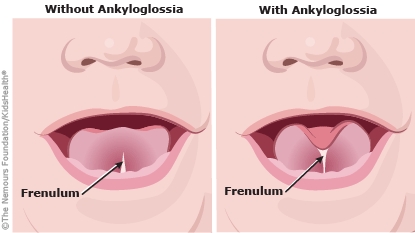Tongue-tie (ankyloglossia) is when the frenulum (the band of tissue that connects the underside of the tongue to the floor of the mouth) is too tight. This prevents the tongue from moving freely. The frenulum stretches as the tongue grows so often no treatment is needed. But if the tongue-tie is causing problems such as poor feeding in babies or trouble with speech in older kids, a minor surgery can help.


Follow your health care provider's advice for:


What causes tongue-tie? It's not clear what causes tongue-tie. It can run in families, so it may be related to certain genes (the parts of cells that determine traits and conditions and can be passed down from parents to children).
What surgery is done for tongue-tie? Most babies and kids don't need surgery for tongue-tie. But if surgery is needed, the ENT, dentist, or oral surgeon can do a: